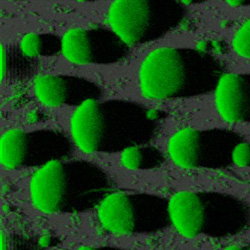Bacterial Growth on Fresh Meat in Supermarket Merchandisers
The heat and UV radiation generated by regular meat display case lighting raises the surface temperature of meat displays and causes bacterial growth to increase exponentially. Vacuum packaging does not prevent bacterial growth; Canada loses $200 million each year due to vacuum packed beef spoiled by lactic acid bacteria.

The microorganisms that attach rapidly to meat surfaces during meat processing and are primarily responsible for meat spoilage are psychrotrophic bacteria, meaning those that are able to grow in cold temperatures, and tend to be in the genus Pseudomonas. Other species of meat bacteria belong to the Moraxella, Pyschrobacter and Acinetobacter genuses.
In ground meats, the bacteria are mixed throughout the meat during the grinding process, but for other cuts of meat, the bacteria are only found on the surface of the meat cuts. While these bacteria are not harmful per se, they consume oxygen which triggers the formation of the brown pigment metmyoglobin, accelerating meat discoloration and decomposition, and can reduce the shelf life of fresh beef to 2 to 3 days.
Meat spoilage from bacterial growth causes organoleptic changes such as an unpleasant odor, a change in color to brown or grey, the formation of slime, the release of toxins, and an off flavor.
Fresh Meat Displays
Regular supermarket meat display case lighting shortens the brief period when meat is blooming, turning it brown prematurely; increases the rate of bacterial growth; and distorts the meat’s natural color.
Retrofitting meat showcases with low radiation, high color definition and long life fluorescents delivers incomparable value and savings to a retail operation. Independent grocers and butcher shops work hard to offer their customers premium cuts of meat, that is why it is so important to use a specialty display case light like Promolux. Promolux lamps and LED lighting compliment the merchandising of fresh foods and supports the retention of color, juices and texture all the while helping to extend the shelf life of the perishable food item.
